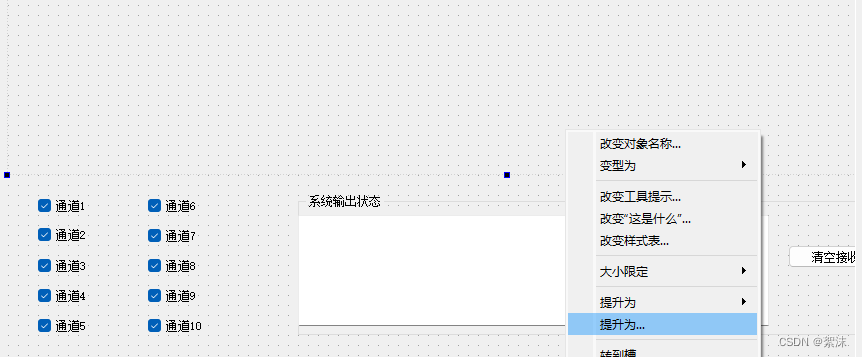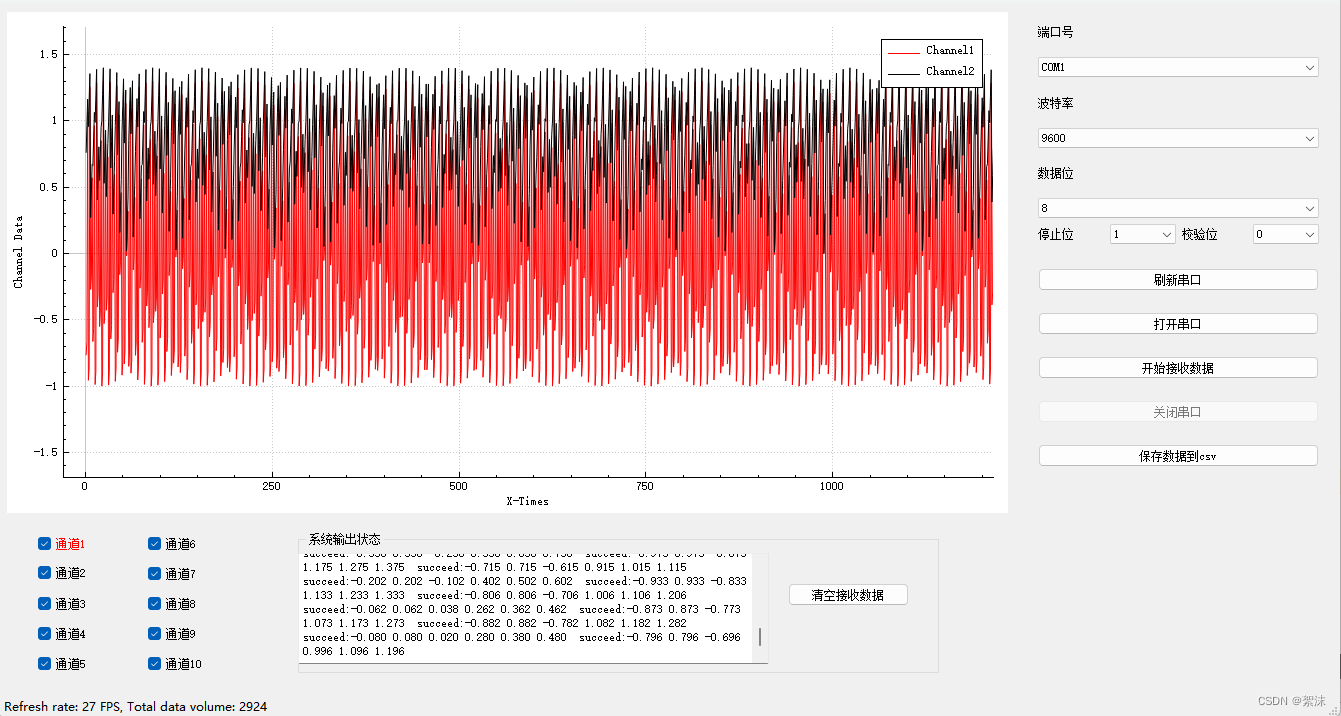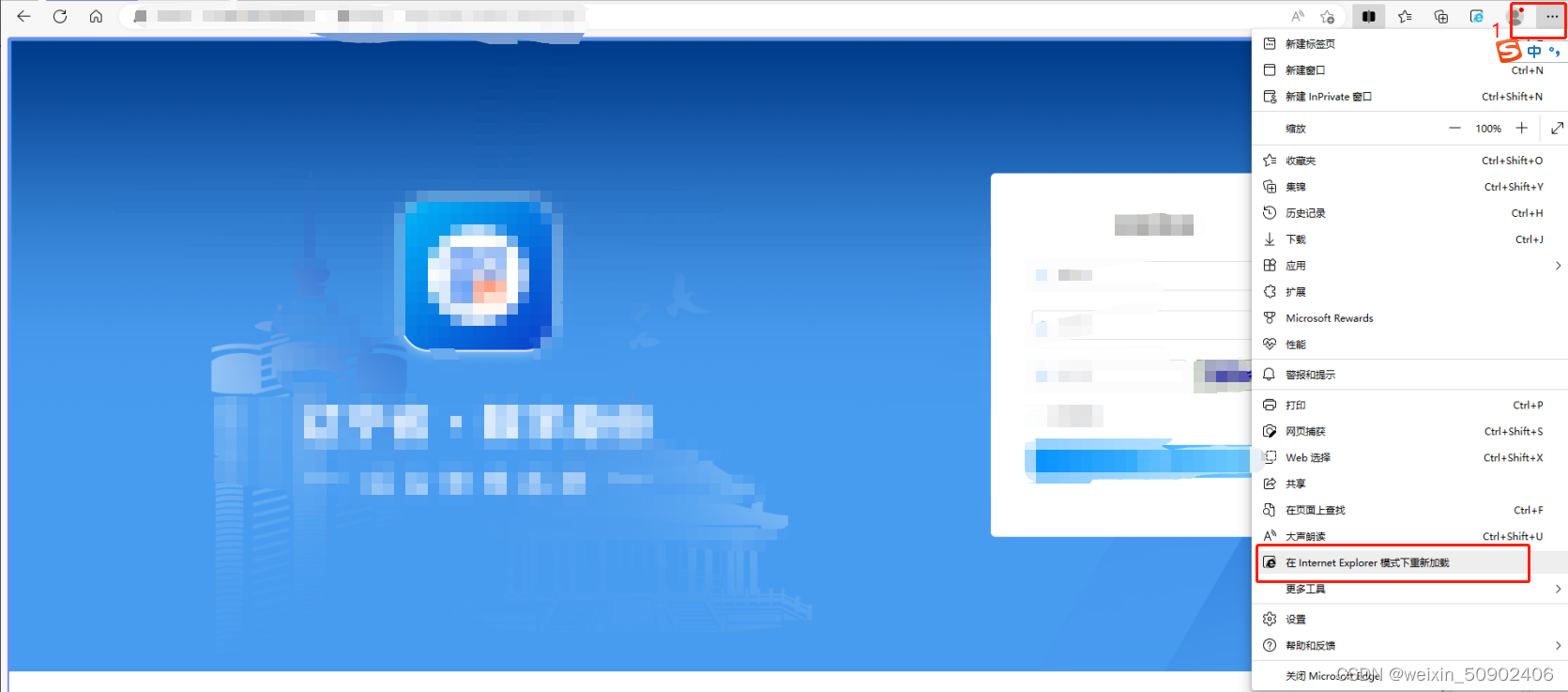QT串口调试助手V2.0(源码全开源)–上位机+多通道波形显示+数据保存(优化波形显示控件)
首先关于Qt的安装和基本配置这里就不做重复说明了,注:本文在Qt5.14基础上完成 完整的项目开源仓库链接在文章末尾
图形控件——qcustomplot
QCustomPlot是一个基于Qt框架的开源绘图库,用于创建高质量的二维图表和数据可视化。
QCustomPlot的主要功能:
绘制多种图表类型:包括折线图、散点图、柱状图、面积图
交互性:支持图表的缩放、平移、数据点选择等交互操作
多轴支持:可以在图表中添加多个X轴和Y轴,以便绘制复杂的多轴图表
定制化:提供丰富的样式和属性设置,用户可以自定义图表的外观,包括颜色、线条样式、标记
高性能:针对大数据量绘图进行了优化,能够处理大量数据点而不影响性能
主要组件:
QCustomPlot:主绘图控件,所有的绘图操作都在这个控件上进行。
QCPGraph:用于绘制常见的折线图和散点图。
QCPAxis:表示图表的轴,可以自定义轴的范围、标签、刻度等。
QCPItem:图表中的各种辅助元素,如直线、文本标签等。
QCPPlottable:可绘制对象的基类,所有具体的绘图类型都继承自这个类。
该控件使用方法
将qcustomplot的源码一个cpp一个h文件添加到项目工程中,并添加头文件和编译链接就可以便捷的在源码中使用了。注意在放置显示控件时需要先放置一个qt内置的QWidget控件,然后通过右键控件,升格,选中头文件和类名称,设置为QCustomPlot,然后源代码中就可以快乐使用了。具体设置的效果可以参考文末完整的项目链接。

绘制曲线数据
主要使用到了曲线控件customPlot->addGraph();
这个控件的使用方法整体上和Qt自带的控件差别不大,主要这个控件的视觉效果和长时间大数据绘制效果更好一些
在使用控件之前要先初始化相关的控件内容:
// 绘图图表初始化
void MainWindow::QPlot_init(QCustomPlot *customPlot)
{
// 创建定时器,用于定时生成曲线坐标点数据
QTimer *timer = new QTimer(this);
timer->start(10);
connect(timer, SIGNAL(timeout()), this, SLOT(Plot_TimeData_Update()));
// 图表添加两条曲线
pGraph1_1 = customPlot->addGraph();
pGraph1_2 = customPlot->addGraph();
// 设置曲线颜色
pGraph1_1->setPen(QPen(Qt::red));
pGraph1_2->setPen(QPen(Qt::black));
// 设置坐标轴名称
customPlot->xAxis->setLabel("X-Times");
customPlot->yAxis->setLabel("Amplitude of channel");
// 设置y坐标轴显示范围
customPlot->yAxis->setRange(-2, 2);
// 显示图表的图例
customPlot->legend->setVisible(true);
// 添加曲线名称
pGraph1_1->setName("Channel1");
pGraph1_2->setName("Channel2");
// 设置波形曲线的复选框字体颜色
ui->checkBox_1->setStyleSheet("QCheckBox{color:rgb(255,0,0)}"); // 设定前景颜色,就是字体颜色
// 允许用户用鼠标拖动轴范围,用鼠标滚轮缩放,点击选择图形:
customPlot->setInteractions(QCP::iRangeDrag | QCP::iRangeZoom | QCP::iSelectPlottables);
}
当向曲线添加新数据的时候可以同时控制范围窗口内的坐标轴尺寸,以及打印一些绘图相关的属性数据
void MainWindow::Plot_Show_Update(QCustomPlot *customPlot, double n1, double n2)
{
cnt++;
// 给曲线添加数据
pGraph1_1->addData(cnt, n1);
pGraph1_2->addData(cnt, n2);
// 设置x坐标轴显示范围,使其自适应缩放x轴
customPlot->xAxis->setRange( 0, (pGraph1_1->dataCount() > 1000) ? (pGraph1_1->dataCount()) : 1000);
// 更新绘图,这种方式在高填充下太浪费资源。rpQueuedReplot,可避免重复绘图。
customPlot->replot(QCustomPlot::rpQueuedReplot);
static QTime time(QTime::currentTime());
double key = time.elapsed() / 1000.0; // 开始到现在的时间,单位秒
//计算帧数
static double lastFpsKey;
static int frameCount;
frameCount++;
if (key - lastFpsKey > 1) // 每1秒求一次平均值
{
// 帧数和数据总数
ui->statusbar->showMessage(
QString("Refresh rate: %1 FPS, Total data volume: %2")
.arg(frameCount / (key - lastFpsKey), 0, 'f', 0)
.arg(customPlot->graph(0)->data()->size() + customPlot->graph(1)->data()->size()),
0);
lastFpsKey = key;
frameCount = 0;
}
}
曲线的绘制效果:

要实现上面的多通道效果还需要自行适配串口解析部分,然后匹配对应的数据后将数值传入到目标曲线对象。
完整的项目源码如下,包含数据解析、串口控制部分、同时实现数据保存到csv文件(代码中只保存了数组前两位的数值,需要保存多少数据可以自行修改代码实现)
项目Cpp文件:
#include "mainwindow.h"
#include "ui_mainwindow.h"
MainWindow::MainWindow(QWidget *parent)
: QMainWindow(parent), ui(new Ui::MainWindow)
{
ui->setupUi(this);
// 给widget绘图控件,设置个别名,方便书写
pPlot1 = ui->widget_1;
// 状态栏指针
sBar = statusBar();
// 初始化图表1
QPlot_init(pPlot1);
cnt = 0;
setWindowTitle("数据采集系统");
serialport = new QSerialPort;
find_port(); //查找可用串口
timerserial = new QTimer();
QObject::connect(serialport,&QSerialPort::readyRead, this, &MainWindow::serial_timerstart);
QObject::connect(timerserial,SIGNAL(timeout()), this, SLOT(Read_Date()));
ui->close_port->setEnabled(false);//设置控件不可用
}
// 析构函数
MainWindow::~MainWindow()
{
delete ui;
}
//查找串口
void MainWindow::find_port()
{
//查找可用的串口
bool fondcom = false;
ui->com->clear();
foreach(const QSerialPortInfo &info, QSerialPortInfo::availablePorts())
{
QSerialPort serial;
serial.setPort(info); //设置串口
if(serial.open(QIODevice::ReadWrite))
{
//
ui->com->addItem(serial.portName()); //显示串口name
fondcom = true;
QString std = serial.portName();
QByteArray comname = std.toLatin1();
//QMessageBox::information(this,tr("SerialFond"),tr((const char *)comname.data()),QMessageBox::Ok);
serial.close();
ui->open_port->setEnabled(true);
}
}
if(fondcom==false)
{
QMessageBox::information(this,tr("Error"),tr("Serial Not Fond!Plase cheak Hardware port!"),QMessageBox::Ok);
}
}
/* 打开并设置串口参数 */
void MainWindow::on_open_port_clicked()
{
update();
//find_port(); //重新查找com
//初始化串口
serialport->setPortName(ui->com->currentText()); //设置串口名
if(serialport->open(QIODevice::ReadWrite)) //打开串口成功
{
serialport->setBaudRate(ui->baud->currentText().toInt()); //设置波特率
switch(ui->bit->currentIndex()) //设置数据位数
{
case 8:serialport->setDataBits(QSerialPort::Data8);break;
default: break;
}
switch(ui->jiaoyan->currentIndex()) //设置奇偶校验
{
case 0: serialport->setParity(QSerialPort::NoParity);break;
default: break;
}
switch(ui->stopbit->currentIndex()) //设置停止位
{
case 1: serialport->setStopBits(QSerialPort::OneStop);break;
case 2: serialport->setStopBits(QSerialPort::TwoStop);break;
default: break;
}
serialport->setFlowControl(QSerialPort::NoFlowControl); //设置流控制
// 设置控件可否使用
ui->close_port->setEnabled(true);
ui->open_port->setEnabled(false);
ui->refresh_port->setEnabled(false);
}
else //打开失败提示
{
// Sleep(100);
QMessageBox::information(this,tr("Erro"),tr("Open the failure"),QMessageBox::Ok);
}
}
/* 关闭串口并禁用关联功能 */
void MainWindow::on_close_port_clicked()
{
serialport->clear(); //清空缓存区
serialport->close(); //关闭串口
ui->open_port->setEnabled(true);
ui->close_port->setEnabled(false);
ui->refresh_port->setEnabled(true);
}
/* 开始接收数据
* */
void MainWindow::on_recive_data_clicked()
{
QString str = "START_SEND_DATA\r
";
QByteArray str_utf8 = str.toUtf8();
if(serialport->isOpen())serialport->write(str_utf8);
else QMessageBox::information(this,tr("ERROE"),tr("串口未连接,请先检查串口连接"),QMessageBox::Ok);
}
void MainWindow::serial_timerstart()
{
timerserial->start(1);
serial_bufferClash.append(serialport->readAll());
}
//串口接收数据帧格式为:帧头'*' 帧尾'#' 数字间间隔符号',' 符号全为英文格式
void MainWindow::Read_Date()
{
QString string;
QStringList serialBuferList;
int list_length = 0;//帧长
QString str = ui->Receive_text_window->toPlainText();
timerserial->stop();//停止定时器
// qDebug()<< "[Serial LOG]serial read data:" <<serial_bufferClash;
QByteArray bufferbegin = "*"; //帧头
int index=0;
QByteArray bufferend = "#"; //帧尾
int indexend = 1;
QByteArray buffercashe;
index = serial_bufferClash.indexOf(bufferbegin,index);
indexend = serial_bufferClash.indexOf(bufferend,indexend);
// qDebug()<< index<< indexend;
int bufferlens=0;
if((index<serial_bufferClash.size())&&(indexend<serial_bufferClash.size()))
{
bufferlens = indexend - index-1;
buffercashe = serial_bufferClash.mid(index+1,bufferlens);
qDebug()<< "[Serial LOG]serial chack data:" <1)
{
clash.data1 = serialBuferList[0].toDouble();
clash.data2 = serialBuferList[1].toDouble();
plot_buffer.push_back(clash);
clash.data1 = serialBuferList[2].toDouble();
clash.data2 = serialBuferList[3].toDouble();
plot_buffer.push_back(clash);
clash.data1 = serialBuferList[4].toDouble();
clash.data2 = serialBuferList[5].toDouble();
plot_buffer.push_back(clash);
}
}
else
{
qDebug()<< "[Serial LOG][ERROR]recive data:" <Receive_text_window->clear();
ui->Receive_text_window->append(str);
serial_bufferClash.clear();
}
/* 刷新串口按键的按钮槽函数
* */
void MainWindow::on_refresh_port_clicked()
{
find_port();
}
// 绘图图表初始化
void MainWindow::QPlot_init(QCustomPlot *customPlot)
{
// 创建定时器,用于定时生成曲线坐标点数据
QTimer *timer = new QTimer(this);
timer->start(10);
connect(timer, SIGNAL(timeout()), this, SLOT(Plot_TimeData_Update()));
// 图表添加两条曲线
pGraph1_1 = customPlot->addGraph();
pGraph1_2 = customPlot->addGraph();
// 设置曲线颜色
pGraph1_1->setPen(QPen(Qt::red));
pGraph1_2->setPen(QPen(Qt::black));
// 设置坐标轴名称
customPlot->xAxis->setLabel("X-Times");
customPlot->yAxis->setLabel("Channel Data");
// 设置y坐标轴显示范围
customPlot->yAxis->setRange(-2, 2);
// 显示图表的图例
customPlot->legend->setVisible(true);
// 添加曲线名称
pGraph1_1->setName("Channel1");
pGraph1_2->setName("Channel2");
// 设置波形曲线的复选框字体颜色
ui->checkBox_1->setStyleSheet("QCheckBox{color:rgb(255,0,0)}"); // 设定前景颜色,就是字体颜色
// 允许用户用鼠标拖动轴范围,用鼠标滚轮缩放,点击选择图形:
customPlot->setInteractions(QCP::iRangeDrag | QCP::iRangeZoom | QCP::iSelectPlottables);
}
int data_lens = 0;
// 定时器溢出处理槽函数。用来生成曲线的坐标数据。
void MainWindow::Plot_TimeData_Update()
{
int lens = plot_buffer.size();
if (lens > data_lens)
{
for(int i=data_lens;i<lens;i++)
{
Plot_Show_Update(pPlot1, plot_buffer[i].data1, plot_buffer[i].data2);
data_lens++;
qDebug()<<"[Plot LOG]data_lens:"<<data_lens<< "size:"<addData(cnt, n1);
pGraph1_2->addData(cnt, n2);
// 设置x坐标轴显示范围,使其自适应缩放x轴
customPlot->xAxis->setRange( 0, (pGraph1_1->dataCount() > 100) ? (pGraph1_1->dataCount()) : 100);
// 更新绘图,这种方式在高填充下太浪费资源。rpQueuedReplot,可避免重复绘图。
customPlot->replot(QCustomPlot::rpQueuedReplot);
static QTime time(QTime::currentTime());
double key = time.elapsed() / 1000.0; // 开始到现在的时间,单位秒
//计算帧数
static double lastFpsKey;
static int frameCount;
frameCount++;
if (key - lastFpsKey > 1) // 每1秒求一次平均值
{
// 帧数和数据总数
ui->statusbar->showMessage(
QString("Refresh rate: %1 FPS, Total data volume: %2")
.arg(frameCount / (key - lastFpsKey), 0, 'f', 0)
.arg(customPlot->graph(0)->data()->size() + customPlot->graph(1)->data()->size()),
0);
lastFpsKey = key;
frameCount = 0;
}
}
/* 清空缓存数据
* */
void MainWindow::on_clean_data_clicked()
{
qDebug()<data().data()->clear();
pGraph1_2->data().data()->clear();
pPlot1->graph(0)->data().clear();
pPlot1->graph(1)->data().clear();
}
// setVisible设置可见性属性,隐藏曲线,不会对图例有任何影响。推荐使用。
void MainWindow::on_checkBox_1_stateChanged(int arg1)
{
if (arg1)
{
pGraph1_1->setVisible(true);
}
else
{
pGraph1_1->setVisible(false); // void QCPLayerable::setVisible(bool on)
}
pPlot1->replot();
}
void MainWindow::on_checkBox_2_stateChanged(int arg1)
{
if (arg1)
{
pGraph1_2->setVisible(true);
}
else
{
pGraph1_2->setVisible(false); // void QCPLayerable::setVisible(bool on)
}
pPlot1->replot();
}
// 保存缓冲区数据为csv文件
void MainWindow::on_savedata_csv_clicked()
{
if(plot_buffer.size()clear(); //清空缓存区
timerserial->stop();
serialport->close(); //关闭串口
ui->open_port->setEnabled(true);
ui->close_port->setEnabled(false);
QString csvFile = QFileDialog::getExistingDirectory(this);
QDateTime current_date_time =QDateTime::currentDateTime();
QString current_date =current_date_time.toString("yyyy_MM_dd_hh_mm");
csvFile += tr("/sensor_Save_%1.csv").arg(current_date);
if(csvFile.isEmpty())
{
QMessageBox::information(this,tr("警告"),tr("文件路径错误,无法打开文件,请重试"),QMessageBox::Ok);
}
else
{
qDebug()<< csvFile;
QFile file(csvFile);
if ( file.exists())
{
//如果文件存在执行的操作,此处为空,因为文件不可能存在
}
file.open( QIODevice::ReadWrite | QIODevice::Text );
QTextStream out(&file);
out<<tr("data1,")<<tr("data2,
"); //写入表头
// 创建 CSV 文件
for (const auto &data : plot_buffer) {
out << QString("%1,%2").arg(data.data1).arg(data.data2) <open(QIODevice::ReadWrite); //打开串口
ui->open_port->setEnabled(false);
ui->close_port->setEnabled(true);
}
完整项目链接->完整的项目工程Github链接



